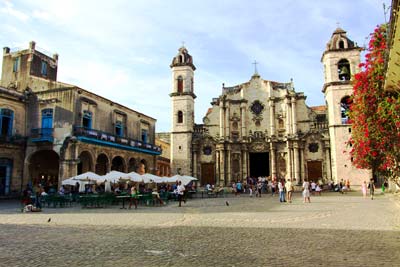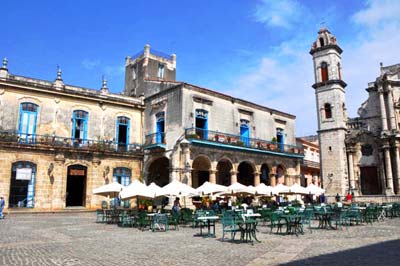The Cathedral Plaza in Havana
Por Luís Suárez, estudiante de periodismo (en la epoca de esta redacción), translated from Spanish by Danil Ren.
The Famous Plaze
The Cathedral Plaza is located in one of the most charming sites of Old Havana, which, since 1982, was declared by the UNESCO as World Heritage Site. Therefore it should not be a surprise that even the stones that make the floor of the place, as well as the emblematic edifications, contribute to provide a singular beauty, always at the visitor's disposal.
Its name is obviously due to the majestic Cathedral that is found inside it, also a key of its history. We could cite, for example, the Marquis de Arcos Palace, the Lombillo or the Bayona houses, and finally the Marquis of Aguas Claras mansion, all these belonged to the colonial nobility of Havana, which today are museum or other cultural centers.
Nevertheless, behind the attracting environment, there is an indlible past, allowing us to return to the origins of these stones and discover that the Cathedral Plaza we see today, was once called the Swamp Plaza, because in this area the water remained stagnated diring several days after a rain or a day of bad sea.
According to the witness of a paper wrote by the Communal Council of Havana, on August 23 1577, the swamp prevented the passage of the people from one side to the other and this was a real obstacle for the majority of those who wanted to attend the holy mass or perform their daily activities. For this reason, the Council evaluated the construction of a bridge, asking collaboration to all those who would benefit from it; despite of that, there is not any evidence that this project would began.
The portion of the plaza that is known as the Callejón del Chorro was the mouth of the Royal Trench, a system that supplied from the Almendares River to distribute water in the city and identified as the first aqueduct in Havana, which in that time was called Villa San Cristóbal de La Habana. This hydraulic view, which benefited inhabitants, but that brought additional humidity to the grounds, were joining with other springs, that, up to 1587, the governor Gabriel de Luján exploited to collect additional water in cistern. Storing water also served up to build some bathrooms a few times later in the same Callejón and to supply vessels, because, some evidences points up that over there, there was the first shipyard of the villa.
Since the second half of the XVI century, some families began to install around this muddy field. But, it was only starting from the XVIII century that the place became one of the most popular, due the settlement of rich people having plenty of prestige at that time.
It's probable that VIPs of that epoch decided to live there because, little by little and naturally, the boggy place dried. It were even restrictions about constructing new houses inside the perimeter that made the place. Therefore its conservation was taken into account very early, even whether some evidences of the swampy past remained.
One of the interested men to invest there was Don Diego Evelino de Compostela of Havana and he did it in the first decade of the XVIII century. This bishop bought a plot and built there a simple chapel that Jesuits transformed later (1778) into the Cathedral of Havana, which distinguish the plaza in face of it.
Not Only the Cathedral
But let go back to the beginning of that century to enter a little more into the personality of the people who lived around the plaza; lots of them have seen the transformations and the first stones of each of the colonial palaces we see today.
The Marqués de Arcos's Palace, for example, was built in the first decade of its century and its façade faces the Cathedral Plaza. Nowadays, this building hosts a museum and an art gallery.
Another of the edifications which distinguish the zone is the Conde de Casa de Lombillo's Residence; which was finished in 1750 and it was considered exceptional because it has three façades. It was inhabited by several families and the owner called Alfonso Hernández asked to the town council an authorization to take 8 yards to make a farmyard; and, even if a portion of the place was used to rear cattles, his neighbor Sánchez Pereira opposed to this madness and prevented the fulfillment of the idea.
Some time after, the mansion belonged to María de la Concepción Montalvo y Pedroso, who received it in inheritance because of marrying the Conde de Casa Lombillo's son, named José María Lombillo y Ramírez de Arellano; for this reason, it is known as the Conde de Lombillo's House, or simply Casa de Lombillo.
María de la Concepción converted herself in a popular home owner, she organized a social gathering every Wednesday, among other parties and nights out assisted by many aristocrats and intellectuals of that time, as well as foreign visitors. It remains clear that the Plaza enjoy, since the beginning, the privilege to be visited by very cultured people from different regions of the world.
The Conde de Lombillo House also was the first city historian's office: the doctor Emilio Roig de Leuchsenring (1889-1964), who created the Havana Historian's Office in 1936. Currently, this residence is part of the Plan Maestro de Revitalización del Centro Histórico (Historic Center Revitalization Master Plan).
Concerning the mansion of Casa Bayona Count, today the Colonial Art Museum, it worth to mention that in 1754, the owner got granted from the town council the license to build a portal. Nevertheless, he eventually didn't built it, otherwise, the place would have been less spacious.
Also, the La Casa del Marqués de Aguas Claras is part of this complicity between the authentic Cuban and the Colonial Art. The building began in the XVIII century and today there is a popular restaurant, El Patio, which has many common points with the Paris one, a previous restaurant that was one of the most popular in Havana between 1904 and 1934.
An Important Plaza
The Plaza has been a scenario for many commercial and cultural activities. A perfect site for many pics and a charming place to walk around in couple or to share with family and friends. According to Emilio Roig de Leuchsenring, the Cathedral Plaza was converted in one of the most elegant places of the city, even rivalizing with the Plaza de Armas.
In the 1930s, it was submitted to a processus of restoration impulsed by the Ministry of Public Works and lidered by the Cuban architect Luís Bay Sevilla, who took into account a project that the French urbanist Jean Claude Nicolas Forestier started. This latter died in 1930, but, before that, he traveled to the city and had prepared an excellent project of urbanization, which included the design of the place floor; for that, he took reference from the plan that Michelangelo realized in Rome for the Capitol Plaza.
The Cathedral Plaza is a symbol of Havana and Cuba. It's not in vain that it was declared a National Monument and it has the power to inspire craftsmen, intellectuals and artists. Don't forget that Havana is one of the seven cities wonder of the world and that, from a swamp, it was born a wonderful place crossing which may be the first action to make dreams reality.












